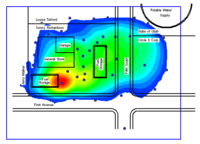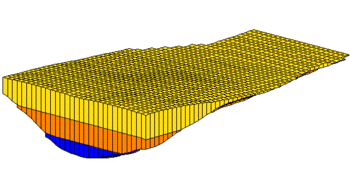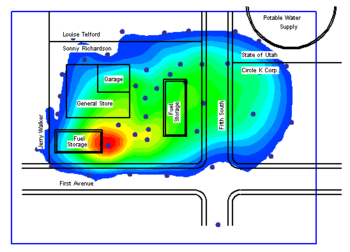GMS:2D Scatter Point Module: Difference between revisions
From XMS Wiki
Jump to navigationJump to search
No edit summary |
No edit summary |
||
| (26 intermediate revisions by the same user not shown) | |||
| Line 1: | Line 1: | ||
{{2D Scatter Point links}} | {{2D Scatter Point links}} | ||
The 2D Scatter Point module is used to interpolate from groups of 2D scattered data to other objects (meshes, grids, TINs). Several [[GMS:Interpolation|interpolation]] schemes are supported, including [[GMS:Kriging|kriging]]. | The 2D Scatter Point module is used to interpolate from groups of 2D scattered data to other objects (meshes, grids, TINs). Several [[GMS:Interpolation|interpolation]] schemes are supported, including [[GMS:Clough-Tocher|Clough-Tocher]], [[GMS:Inverse Distance Weighted|inverse distance weighted]], and [[GMS:Kriging|kriging]]. | ||
Interpolation is useful for setting up input data for analysis codes and for site characterization. The two figures below show examples of using interpolation. | Interpolation is useful for setting up input data for analysis codes and for site characterization. The two figures below show examples of using interpolation. | ||
[[Image:Sample_LayInterp. | {| | ||
|- | |||
|valign="top"|[[Image:Sample_LayInterp.png|thumb|350px|Interpolation of Modflow layer elevations to a 3D grid]] | |||
|[[Image:samp_2dscat.png|thumb|350px|Sample interpolation for site characterization]] | |||
|} | |||
[[ | A number of [[GMS:2D Scatter Point Tool Palette|tools]] are included for creating and manipulating 2D scatter point sets. In general, 2D scatter sets are imported using the [[GMS:File Import Wizard|''File Import Wizard'']]. 2D scatter sets can also be [[GMS:2D Scatter Point Set Creation and Editing|created]] from other objects in GMS such as GIS objects, feature objects, meshes, grids, TINs, etc. | ||
Multiple 2D scatters sets can be in the module. Existing scatter sets can be duplicated or merged together. | |||
Besides interpolating 2D scatter sets to other data, the module can also be used to [[GMS:Converting 2D Scatter Points to Other Types of Data|create objects (meshes, grids, TINs)]] from the scatter data. | |||
The module contains its own [[GMS:2D Scatter Point Display Options|display options]] which include [[GMS:Contour Options|contour]] displays. Also, each scatter point has an [[GMS:Active/Inactive Points|active/inactive]] status. A scatter point with an inactive status can be displayed, but the dataset value at the point is ignored when interpolation takes place. | |||
The 2D Scatter Point module also allows exporting scatter sets by right-clicking on the scatter set and selecting the '''Export''' command. Options for export include: Text Tab Deliminated 2D Scatter Point Files (*.txt), Text GMS 2D Scatter Point Files (*.xy), and Shapefiles (*.shp). | |||
| Line 12: | Line 24: | ||
[[Category:2D Scatter Point]] | [[Category:2D Scatter Point]] | ||
[[Category:Interpolation]] | [[Category:Interpolation]] | ||
[[Category:Scatter Modules]] | |||


